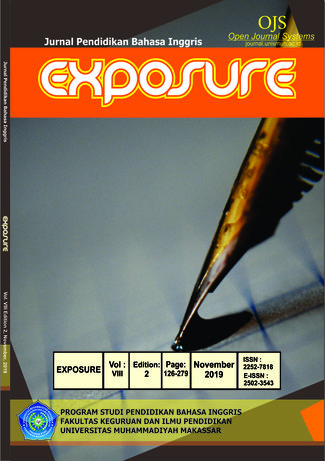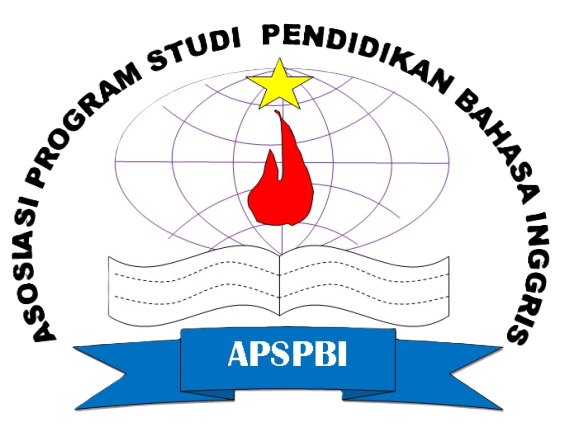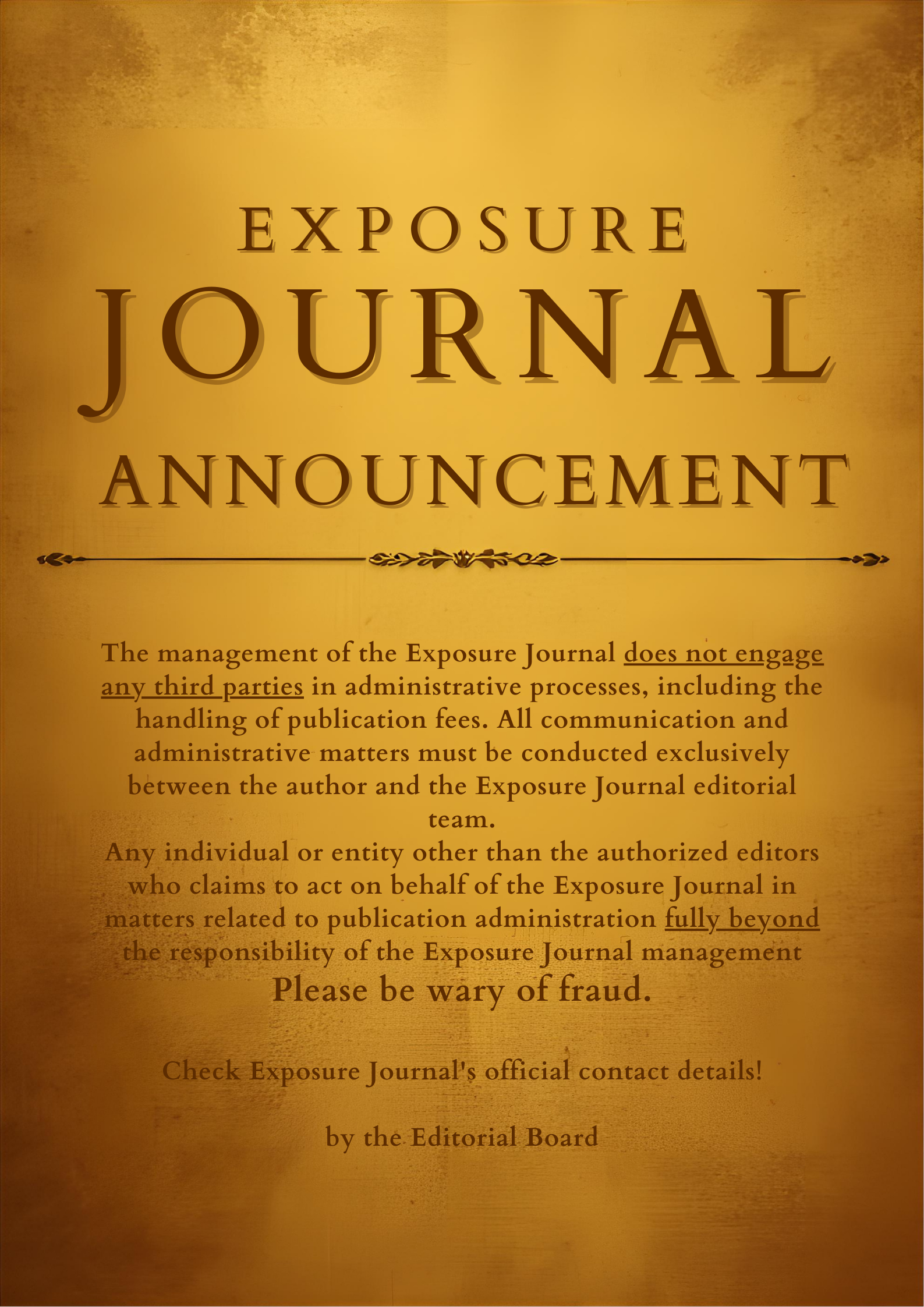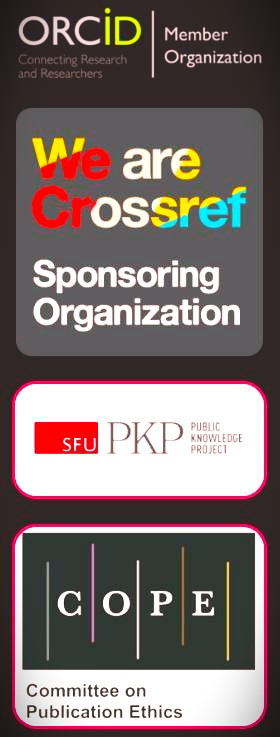THE STUDENTS’ LEARNING INTEREST OF QUIPPER SCHOOL USED BY THE TEACHER IN TEACHING ENGLISH: Descriptive Research
DOI: https://doi.org/10.26618/exposure.v8i2.2800
Perception, Media, Students’ Perception, Teacher’s Media
Abstract
This research aims to investigate the students’ interest in learning English towards the use of Quipper School. In this study, 45-eighth-grade students from three classes at Lab SMP School Unismuh Makassar responded to 20-items of the questionnaire about the use of Quipper School in learning English. The data were then analyzed by means of a descriptive quantitative method followed by the random sampling technique to take the sample. The response of this questionnaire was concluded to answer the research question. The results show that most of the students were interested in Quipper School as a medium of learning English in the class. Some of the most appealing features of Quipper School encompassed self-evaluation, cognitive training, accessibility and updated material. These made them be comfortable with learning English which motivated them to study in order to enhance their English skill. Thus, the use of Quipper School was likely to be an effective medium of instruction, and English Teachers should consider incorporating its use in their classrooms. Eventually, it ensured that they would be prepared to communicate with English as a common language used in the globalization era.
References
Abbad, Moris & Nahlik. 2009. Factors Affecting Student Adoption of E-Learning Systems in Jordan. The International Review of Research in Open and Distance learning.
Amalia, Dewi Saptani. 2017. Perception towards the use of Quipper School in Teaching English. Semarang: Universitas Negeri Semarang.
Arsyad. 2011. Media Pembelajaran. Jakarta: PT. Raja Grafindo Persada Baru Algensindo.
Asep & Syahrul. 2016. Quipper School: How Do Teachers Bring it in the Classroom? Yogyakarta: Ahmad Dahlan University.
Arief S. Sadiman, et all. 1986. Seri Pustaka Teknologi Pendidikan No.6 Media Pendidikan. Pengertian, Pengembangan, dan Pemanfaatannya. Jakarta: CV Rajawali.
Arikunto, Suharsimi. 2002. Prosedur Penelitian: Suatu Pendekatan praktek (A Practical Approach). Edisi revisi V. Rineka Cipta. Jakarta.
Burke, Synder, & Rager. 2009. An Assessment of Faculty Usage of YouTube as a Teaching Resource. The Internet Journal of Health Science and Practices, 7(1), 8. Retrieved from http://nsuworks.nova.edu/ijahsp/vol7/iss1/8
Chapelle. 2003. Quipper School and its Effectiveness in the Academic Performance of Grade Method. International Journal of Transformations in Business Management.
Cox. 2009. Teachhub. Retrieved from: http://www.teachhub.com/benefits-technology-classroom. Accessed in 27 September 2015
Dempsey & Van Eck. 2007. Trends and Issues in Instructional Design and Technology. Upper Saddle River, NJ: Pearson.
Deci & Ryan. 2004. factors affecting students' interest in English at the senior High School. Unpublished Master Dissertation.
Forsyth. 2001. The Theory and Practice of Online Learning. Edmonton: AU Press.
Ghavifekr. 2012. Management strategies for E-learning system as the core component of systematic change: A qualitative analysis. Life Science Journa, 9(3), 2190-2196.
Hidi & Renninger. 2006. The four-phase model of interest development. Educational Psychologist, 41, 111 – 127.
Havivah. 2015. The Effect of Quipper School on the Performance of Grade Students of Bacoor National High School: Gawaran.
Kemp & Dayton. 2002. Planning and producing instructional media (2nd ed). New York: Harper & Row Publishers Cambridge, p. 3.
Lester, et all. 2002. Human Development and Learning. New York: American Book Company.
Liaw. 2007. Exploring the World Wide Web for online learning: a perspective from Taiwan. Educational Technology 40 (3): 27-32.
Mason & Rennie. 2010. e-Learning Panduan Lengkap Memahami Dunia Digital dan Internet. Yogyakarta: Pustaka Baca
Morron, A. 2015. The effect of Quipper School on the performance of the Grade 7 Students of Baccor National High School – Gawaran in Teaching Mathematics.
Mulyono, Herri. 2013. Using Quipper as an Online Platform for Teaching and Learning English As a Foreign Language. Jurnal Teaching English with Technology, 16(1), 59-70.
Putra. 2013. Desain Belajar Mengajar Kreatif Berbasis Sains. Yogyakarta: Diva Press
Rizki. 2015. Keefektifan Penerapan E-Learning Quipper School Pada Pembelajaran Akuntansi di SMA Negeri 2 Surakarta. UNS Volume 01 Nomor 01 Tahun 2015. Accessed in 18 September 2015.
Sadiman, et all. 2010. Media Pendidikan. Jakarta: Rajawali Pers.
Sadirman. 2003. Interaksi dan Motivasi Belajar Mengajar. Jakarta: PT. Raja Grafindo Persada.
Sangra. (2012). Building an inclusive definition of e-learning: An approach to the conceptual framework. Retrieved http://www.irrodl.org/index.php/irrodl/article/view/116. Accessed in 27 September 2015
Schramm. 1997. Perceptions of Social Media as a Learning Tool: A Comparison Between Arts and Science Students. International Journal of Social Media and Interactive Learning Environments,4(1), 92-108.
Sudjana & Rifai. 2005. Penilaian Hasil Proses Belajar Mengajar. Bandung: PT. Remaja Rosdakarya.
Sugiyono. 2016. Metode Penelitian Pendidikan (Educational Research Methods). Bandung: Penerbit Alfabeta.
Sukawatie. 2018. Using Quipper School Website as an Online Assessment for English Teaching and Learning. Surakarta: Sebelas Maret University
Surjono. 2011. Membangun Course e-Learning berbasis Moodle. Yogyakarta: UNY Press.
Teemant. 2010. ESL Student Perspectives on University Classroom Testing Practices. Journal of the Scholarship of Teaching and Learning, 10(3), 89-105.
Watanabe, Masayuki. 2014. Quipper School Indonesia. Retrieved from: http://indonesia.quipperschool.com. Accessed in 25 September 2015.
Downloads
Published
How to Cite
Issue
Section
License
Authors who publish with this journal agree to the following terms:
In order to assure the highest standards for published articles, a peer review policy is applied. In pursue of the compliance with academic standards, all parties involved in the publishing process (the authors, the editors and the editorial board and the reviewers) agree to meet the responsibilities stated below in accordance to the Journal publication ethics and malpractice statement.
Duties of Authors:
- The author(s) warrant that the submitted article is an original work, which has not been previously published, and that they have obtained an agreement from any co-author(s) prior to the manuscript’s submission;
- The author(s) should not submit articles describing essentially the same research to more than one journal;
- The authors(s) make certain that the manuscript meets the terms of the Manuscript Submission Guideline regarding appropriate academic citation and that no copyright infringement occurs;
- The authors(s) should inform the editors about any conflict of interests and report any errors they subsequently, discover in their manuscript.
Duties of Editors and the Editorial Board:
- The editors, together with the editorial board, are responsible for deciding upon the publication or rejection of the submitted manuscripts based only on their originality, significance, and relevance to the domains of the journal;
- The editors evaluate the manuscripts compliance with academic criteria, the domains of the journal and the guidelines;
- The editors must at all times respect the confidentiality of any information pertaining to the submitted manuscripts;
- The editors assign the review of each manuscript to two reviewers chosen according to their domains of expertise. The editors must take into account any conflict of interest reported by the authors and the reviewers.
- The editors must ensure that the comments and recommendations of the reviewers are sent to the author(s) in due time and that the manuscripts are returned to the editors, who take the final decision to publish them or not.
Authors are permitted and encouraged to post online a pre-publication manuscript (but not the Publisher’s final formatted PDF version of the Work) in institutional repositories or on their Websites prior to and during the submission process, as it can lead to productive exchanges, as well as earlier and greater citation of published work (see The Effect of Open Access). Any such posting made before acceptance and publication of the Work shall be updated upon publication to include a reference to the Publisher-assigned DOI (Digital Object Identifier) and a link to the online abstract for the final published Work in the Journal.














